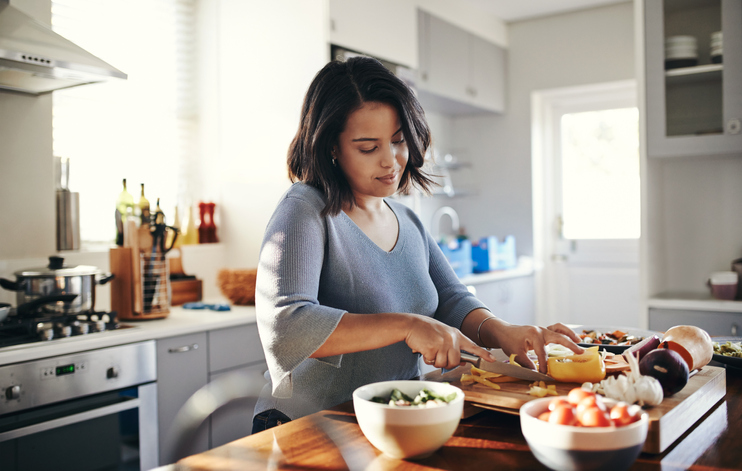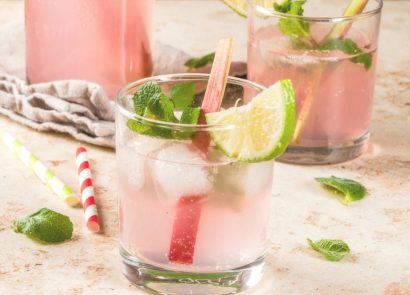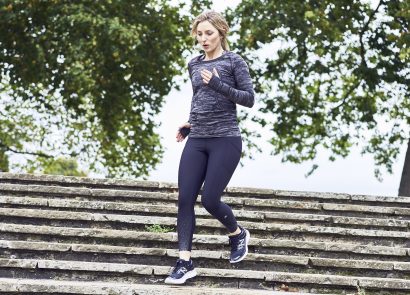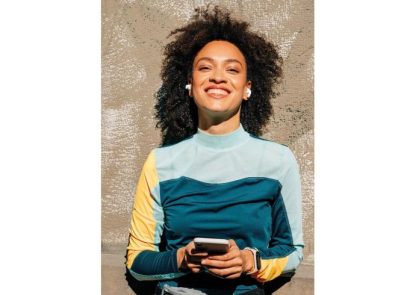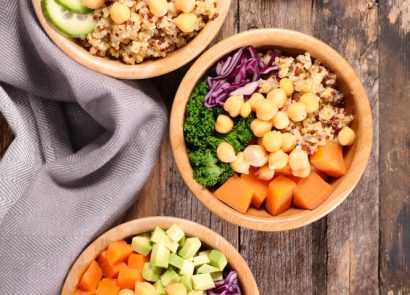Your midday meal shouldn’t have to be a chore (or a bore, for that matter), but our reluctance to try new things might be getting in the way of a healthy, balanced lunch that will keep us full until dinner time. According to a new study, a third of Brits eat the same lunch every day, with the humble sandwich prevailing, so to save you from any more lunchtime boredom (no offence, bread), we’ve borrowed the brains of the UK’s leading nutritionists to offer their tips for mastering food prep, ingredients for a balanced bowl and healthy swaps you can incorporate right now. Plus, you’ll be wanting to eat these delicious and satiating recipes on rotation. Experts, the floor is yours…
How can I build a healthy lunch?
Despite what the decor on your wall might say, a balanced diet doesn’t mean a burger in one hand and a glass of wine in the other, sorry. Instead, you need to include the three macronutrients (protein, fats and carbohydrates) to promote muscle growth and harness energy. “Start off by choosing a form of protein, whether that be meat, fish or a vegetarian alternative, and then build your lunch around it,” explains Vanessa Gebhardt, qualified nutritionist for Freeletics (freeletics.com). “By focusing on high-quality protein first and then adding vegetables and carbs around that, you get a perfect meal structure.” Head of Healthspan Nutrition (healthspan. co.uk), Rob Hobson agrees, adding that once you’ve built your bowl around the key food groups, you can focus on the taste. “There are so many interesting ways to flavour food, and herbs and spices are a good place to start, as they also add extra nutrition in the form of minerals and antioxidant compounds. Citrus juices and dried fruit are always a good addition and work well in savoury foods, such as tagines, stews and salads.”
What’s the best way to ensure I stay full until dinner time?
If you haven’t eaten a balanced meal, your blood-sugar levels can mimic that of a roller coaster you might find at your nearest theme park, with them spiking and suddenly plummeting, leaving you hungry again before you can say ‘3pm slump’. “Ideally, the more whole the food is, the more fibre it contains and that takes longer to be digested, helping you to feel full for longer,” states leading nutritionist Dr Marilyn Glenville (glenvillenutrition.com). Beans and pulses are fibre champions, and you may want to prioritise those over rice or grains, explains Rob: “Legumes are high in protein, but still contain a little complex carbohydrates to help bulk out the meal, and slow down the release of energy from food, creating a fuller for longer effect.” However if you do need to snack, Marilyn recommends something like an apple or a handful of nuts to keep those biscuit and chocolate cravings at bay.
Any tips for prepping lunch the night before?
Nothing says winning at life more than five full Tupperware containers ready for the working week ahead, so what do the experts recommend for your best #mealprep game? “Some foods, such as bread and salad, can become soggy or brown if left in the fridge, so should be wrapped in packaging to help them last longer,” advises Dr Leon Creaney, sports and exercise medicine doctor at the Manchester Institute of Health and Performance, part of HCA UK (hcahealthcare.co.uk). But be wary of some animal proteins, as their shelf life can expire quickly. “Pasta keeps well, as does chicken, but red meats such as beef and particularly pork can go off quickly, especially in warm weather.” Batch cooking is also a great method to save time, plus it’s a fail-safe way to avoid trips to a coffee chain for a less-than-satiating panini. “Think about batch cooking at the start of the week and then plan out how to turn that meal into several others across the week,” says Rob. Any quick cheats? “Make use of leftovers. If you’ve made a chilli, for example, then why not turn it into a wrap with salad for lunch the following day? To make things less time consuming the night before, invest in pre-cooked grains, as these are super easy to turn into meals.”
What makes the perfect post-workout lunch?
Fitting in a workout during your lunch hour is not only an efficient time-saver, it might mean you crave less processed foods after your sweat sesh too, so how should you refuel? “There is the concept of the ‘golden’ first hour after a workout, when muscles are glycogen-depleted and need quickly refuelling with glucose,” explains Dr Leon. Rather than the time of day when you can take the best selfies, the golden hour after exercise is important, as eating the right nutrients can speed up the recovery process of the muscles that have been broken down or damaged due to exercise. “This is one of the rare instances where sugary or protein drinks can be useful and recommended. Following this, a meal rich in carbohydrate and protein is excellent for refuelling and building muscle tissue.
Level up your lunch
Chicken quinoa and greens bowl

120g uncooked quinoa • 2 tbsp olive oil • 4 chicken breasts • 2 tsp smoked paprika • 2 tsp dried oregano • 1 tsp cayenne pepper • Juice of 1 lemon • 2 sweet potatoes • 100g green beans (frozen or fresh) • 100g frozen petit pois • 90g baby leaf salad
For the dressing:
• 100g Greek yoghurt 0% fat • ½ lemon, juiced
• ½ tsp garlic powder • 4 tbsp cold water
• A pinch of salt and pepper • A handful of mint leaves
1. Preheat the oven to 200C/400F/ Gas 6, then rinse the quinoa with cold water. Place the quinoa in a large pan, pour over 450ml boiling water and bring to a simmer for 20 minutes.
2. Chop the sweet potato into chunks, spray with oil spray and place on a roasting tray.
3. Add the smoked paprika, oregano, cayenne pepper, lemon juice, olive oil and a good pinch of salt and pepper in a bowl, add the chicken breasts and stir to coat. Place the chicken on a separate roasting tray. Then, put the chicken and sweet potato in the oven for 20-25 minutes until the chicken is cooked through.
4. Meanwhile, make the dressing by mixing the yoghurt, lemon juice, garlic, salt, pepper and water together in a bowl; slice a few mint leaves and stir these through.
5. Roughly chop the green beans (don’t worry about this if they’re frozen). Then add these to the quinoa pan along with the petit pois for the last 5-7 minutes of quinoa cooking time.
6. The quinoa should absorb all the water, but if not then drain off any excess, tip into a bowl and fluff up with a fork.
7. Add the baby leaf salad and roasted sweet potato to the quinoa and mix it all together.
8. Slice the chicken into small pieces and serve over the salad, then drizzle the yoghurt dressing all over.
Rob says: “The chicken offers a good source of protein, and the quinoa and sweet potato add a little complex carbohydrates, both of which are high in fibre and brimming with key vitamins and minerals, including beta carotene and magnesium.”
Tuscan panzanella salad with chick peas and roasted peppers

• 5 medium tomatoes • 2 large handfuls of salad leaves • ½ tin of chickpeas • ½ red onion • ¼ tsp of smoked paprika • 1 pepper • Approx. 75ml olive oil • 2 large slices of stale/crusty bread • 1 large heaped tbsp of capers • 1 ball of fresh mozzarella
For the dressing:
• 30g herbs (such as dill, basil, parsley, chives) • 2 tbsp lemon juice • 50ml olive oil • 50ml white wine vinegar • ½ tsp sea salt
1. In a pan, generously drizzle approximately 50ml of olive oil (or evenly to coat the pan) and add your bread. Toss until golden and crispy and season with a little sea salt. Then place to the side.
2. Preheat your oven to 160C/325F/ Gas 3. Slice your pepper and add your chickpeas to an oven tray with 25ml of olive oil, paprika and sea salt and roast for around 10 minutes. Remove them from the oven and let them cool on the side.
3. Roughly chop your herbs and pop in a bowl. With a blender, whizz up a mixture of soft herbs with olive oil, white wine vinegar and lemon juice. If it isn’t runny enough, add a little more oil and vinegar. Season to taste.
4. Chop up your tomatoes into chunky segments and thinly slice the red onions. In a large mixing bowl, add your tomatoes, onions, capers, chickpeas, pepper and bread. Add a drizzle of olive oil and mix. Leave for 5 minutes.
5. Add your salad leaves to your plate and pile on your panzanella. Finish with torn fresh mozzarella, some fresh herbs and drizzle your herb dressing on top.
Leon says: “This meal contains an excellent balance of all the major food groupings. There are portions of fruit tomatoes and veg, carbs, protein and dairy, fibre and mono and polyunsaturated fat, which is great for lowering cholesterol.”
Salmon rainbow salad bowl

• 8 new or baby potatoes • 8 cauliflower florets • 8 stems of purple sprouting broccoli • 2 tbsp rapeseed oil • 2 tbsp turmeric • 2 salmon fillets • 2 red peppers, sliced • 2 handfuls of watercress or rocket
For the dressing:
• 3 tbsp low fat yoghurt • 2 tsp rapeseed oil • 2 tsp lemon juice • Zest of a lemon • 1 tbsp fresh tarragon, finely chopped • Salt and black pepper, to season
1. Preheat the oven to 200C/400F/ Gas 6.
2. Mix the turmeric and oil together, then place the broccoli and cauliflower onto a roasting dish, drizzle with 1 tbsp of the turmeric and oil and roast for 10-15 minutes. Add the red pepper and roast for another 10 minutes until tender.
3. Wash the potatoes and simmer gently in salted water for around 10-15 minutes until they’re tender and cooked through. Remove from heat, drain and cut into bite-sized chunks.
4. Meanwhile, place the salmon onto a roasting tin, spread with the remaining turmeric mix, season and roast for 15 minutes.
5. Mix all the ingredients for the dressing together in a large bowl. Once the potatoes, broccoli and cauliflower have cooled, place them into the bowl with the dressing along with the watercress.
Marilyn says: “The salmon is a really good protein source, as it provides healthy omega 3 essential fatty acids that are important for general health and also help to control inflammation.”









